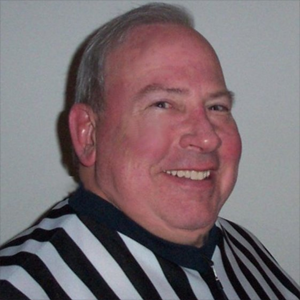
Rndballref
20 Years Experience
Chicago, IL
Male, 60
For twenty years I officiated high school, AAU and park district basketball games, retiring recently. For a few officiating is the focus of their occupation, while for most working as an umpire or basketball referee is an avocation. I started ref'ing to earn beer money during college, but it became a great way to stay connected to the best sports game in the universe. As a spinoff, I wrote a sports-thriller novel loosely based on my referee experiences titled, Advantage Disadvantage
Pushing an opponent is a foul. but the severity must be judged by the official. If it is immaterial to the play I would generally ignore (unless it is escalating into a potential pushing fight).
This error is correctable, as long as it is discovered during the first dead ball after the clock has been started. When B1 scores, the ball is dead and the free throw should be awarded. The points scored by B1 shall remain counted.
While it is not ideal, a game can begin with 1 referee. It seems that it happens occasionally at the lower levels but rarely at the Varsity level because if the Varsity crew is short a ref, they will invite a ref from the pre-lim (usually sophomore) game to stay and work the game with them.
When I have had to ref myself, I find that play under the basket gets rough because the players know that you can only follow the ball. You also miss a lot of line calls.
It is subject to your interpretation.
Debate Coach
 Are presidential debates actually "debates", by the traditional definition?
Are presidential debates actually "debates", by the traditional definition?
HR Executive
 What's the worst reaction you ever witnessed during a lay-off?
What's the worst reaction you ever witnessed during a lay-off?
Videogame Reviewer
 Pick one: Nintendo Ice Hockey, NHL ‘94, or Blades of Steel?
Pick one: Nintendo Ice Hockey, NHL ‘94, or Blades of Steel?
I do not have any special knowledge of AAU league or tournament rules. I do know that age verification is a perpetual problem in traveling basketball.
If your partner said that he whistled the ball dead inadvertently, it does not matter if no one in the gym heard it - the ball was dead when he blew his whistle. He should have taken the points off the board, apologized to the coach and put the ball in play at the point of the inadvertent whistle.
If the ball is live, then any foul can be called. If the ball is dead, the only foul which can be called is a technical.
On a throw in, the ball is live (even though the clock is not running) when it is at the disposal of throw in player ... in other words when the referee hands or bounces the ball to the player. So, yes a common foul can be called before the clock runs.
-OR-
 Login with Facebook
Login with Facebook (max 20 characters - letters, numbers, and underscores only. Note that your username is private, and you have the option to choose an alias when asking questions or hosting a Q&A.)
(A valid e-mail address is required. Your e-mail will not be shared with anyone.)
(min 5 characters)
By checking this box, you acknowledge that you have read and agree to Jobstr.com’s Terms and Privacy Policy.
-OR-
 Register with Facebook
Register with Facebook(Don't worry: you'll be able to choose an alias when asking questions or hosting a Q&A.)